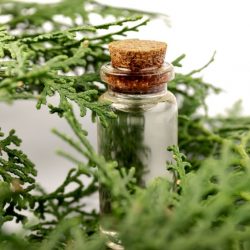Who hasn’t crumpled a sprig of rosemary between their fingers to release its powerful, fresh aroma? Much more than just an aromatic herb, rosemary has earned a reputation throughout the ages as a plant with a thousand virtues. Already revered in ancient times, it was used both to honour the gods and for its medicinal benefits. Today, rosemary cineole essential oil remains a precious ally in aromatherapy. Let’s find out why it is so highly prized in phytotherapy.
A little history
Rosemary was an integral part of the recipe for “Vinaigre des Quatre Voleurs”, a germicidal maceration used in particular to prevent the Great Plague, and was preserved for a long time in the form of a monograph in the Pharmacopoeia. It was also used in the formulation of Paracelsus ‘ ‘Oppodeldoch’ to combat all types of rheumatic pain, as well as gout.
Can a simple potion really restore vitality and youthfulness? At least, that’s the fascinating story behind Eau de la Reine de Hongrie: a rosemary-based alcoholate which, according to legend, restored freshness and energy to a 72-year-old sovereign… so much so that she seduced and married the King of Poland! In 1378, aged 72 and suffering from gout and paralysis, she received the formula for this elixir from a monastery, which miraculously restored her vitality, freshness and beauty… and she subsequently married the King of Poland, despite her advanced age.
What are the pharmacological properties of Rosemary ct Cineole essential oil?
Since those ancient times, modern science has confirmed what the ancients already sensed: rosemary is packed with health-giving properties. From its stimulating action to its antimicrobial effects, this essential oil deserves our full attention.
Antimicrobial effect :
An antibacterial action has been demonstrated against staphylococcus aureus, streptococcus andEscherichia coli. Antifungal action has been demonstrated against Candida albicansand dermatophytes, as well as antiviral action against the herpes virus.
Expectorant effect:
Anticatarrhal and expectorant, rosemary is also mucolytic. An ideal natural remedy in winter, especially when you’re looking to clear the bronchial tubes gently and effectively.
Stimulating effect :
Rosemary ct cineole essential oil has a stimulating effect on the central nervous system, increasing breathing amplitude. A real boost for the mind, perfect for diffusing during a work or study session.
Anti-inflammatory and analgesic effects:
Specifically for infectious or inflammatory pulmonary and respiratory conditions, rosemary ct cineole essential oil is cortisone-like but also an excellent external analgesic.
Rubefacient effect :
This effect is linked to vasodilatation of peripheral vessels. Be careful to dilute well: I tried a pure application once, and my skin still remembers it!
Other effects:
- Muscle tonic and circulatory tonic (venous and arterial)
- Cerebral tonic
- Revulsive
- Fluidifier for bronchial secretions
- Hepatoprotective in low doses, provided the camphor content does not exceed 10-15%
- Antioxidant, protecting DNA from damage induced by hydrogen peroxide (H2O2)
Does Rosemary ct Cineole essential oil require any precautions for use?
- Risk of neurotoxicity at high doses (may induce convulsions, nausea and vomiting)
- Contraindicated in people with epilepsy or a history of convulsions
- Hypertensive in moderate doses
- Do not diffuse, inhale or add to bath water
- Do not swallow! ESCOP advises against using this essential oil orally
- Forbidden for internal use
- For cutaneous use only
- Not recommended for pregnant (abortive) or breast-feeding women
- Do not use in combination with cortisone, as there is a risk of drug interaction
- Do not use over a prolonged period, as there is a risk of resting the pituitary-adrenal axis and suffering acute adrenal insufficiency when the essential oil is stopped
- Avoid applying the essential oil in the evening (or before any period of rest)
- Not recommended for people suffering from osteoporosis, due to the inherent risk of decalcification
- Dermocaustic; revulsive action on the skin in its pure state and aggressive to mucous membranes (redness, irritation, pruritus), dilution required
- Enzyme inhibitor, risk of drug interactions, ask your pharmacist for advice
- Not recommended for asthmatics
- For adults only! The EMA reserves the use of rosemary essential oil for people over the age of 18
- Use with caution by people suffering from autoimmune diseases, the elderly, people with Parkinson’s disease and neurosensitive people
- Drug interactions with essential oils containing more than 10% sesquiterpenes
Rosemary cineole essential oil is one of nature’s nuggets, as long as you use it correctly. Whether it’s to boost energy, support immunity or soothe muscular tension, it’s an easy addition to any well-being routine. Have you already tried this essential oil? Share your experience in comments
Medical literature and clinical trials:
- Melo GA, Grespan R, Fonseca JP, Farinha TO, Silva EL, Romero AL, Bersani-Amado CA, Cuman RK. Rosmarinus officinalis L. Essential Oil Inhibits In Vivo and In Vitro Leukocyte Migration. J Med Food. 2011
- Takaki I, Bersani-Amado LE, Vendruscolo A, Sartoretto SM, Diniz SP, Bersani-Amado CA, Car RK. Anti-inflammatory and antinociceptive effects of Rosmarinus officinalis L. essential oil in experimental animal models. J Med Food. 2008
- Jirovetz L, Buchbauer G, Denkova Z et all. Antimicrobial testings and gas chromatographic analysis of pure oxygenated monoterpenes 1,8-cineol, alpha-terpineol, terpinene-4-ol and camphor as well as car target compounds in essential oils of pine (Pinus pinaster), rosemary (Rosmarinus officinalis), and tea-tree (Melaleuca alternifolia). Sci Pharm.2005
- Luqman car S, Dwivedi GR, Darokar MP, Kalra A, Khanuja SP. Potential of rosemary oil to be used in drug-resistant infections. Altern Ther Health Med. 2007
- Sagorchev P, Lukanov J, Beer AM. Investigations into the specific effects of rosemary oil at the receptor car level. Phytomedicine. 2010
- Von Schoen-Angerer T, Deckers B, Henes J, Helmert E, Vagedes J. Effect of topical rosemary essential oil on Raynaud phenomenon in car systemic sclerosis. Complement Ther Med. 2018
- Vagedes J, Henes J, Deckers B, Vagedes K, Kuderer S, Helmert E, von Schoen-Angerer T. Topical Rosmarinus officinalis L. in Systemic Sclerosis-Related Raynaud’s Phenomenon: An Open-Label Pilot Study. Complement Med Car Res. 2022
- Horvathova E, Navarova J, Galova E, Sevcovicova A, Chodakova L, Snahnicanova Z, Melusova M, Kozics K, Slamenova D. Assessment of antioxidative, chelating, and DNA-protective effects of selected essential oil components (eugenol, car vacrol, thymol, borneol, eucalyptol) of plants and intact Rosmarinus officinalis oil. J Agric Food Chem. 2014
- Moss M, Oliver L. Car H. Plasma 1,8-cineole correlates with cognitive performance following exposure to rosemary essential oil aroma. Therapeutic Advances in Psychopharmacology. 2012
- Moss M, Cook J, Wesnes K, Duckett P. Aromas of rosemary and lavender essential oils differentially affect cognition and mood in healthy adults. Int J Neurosci. Car. 2003





